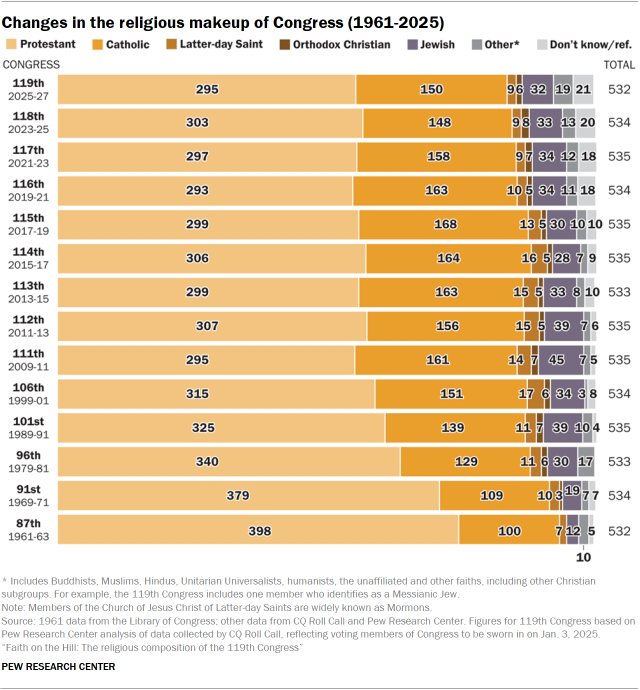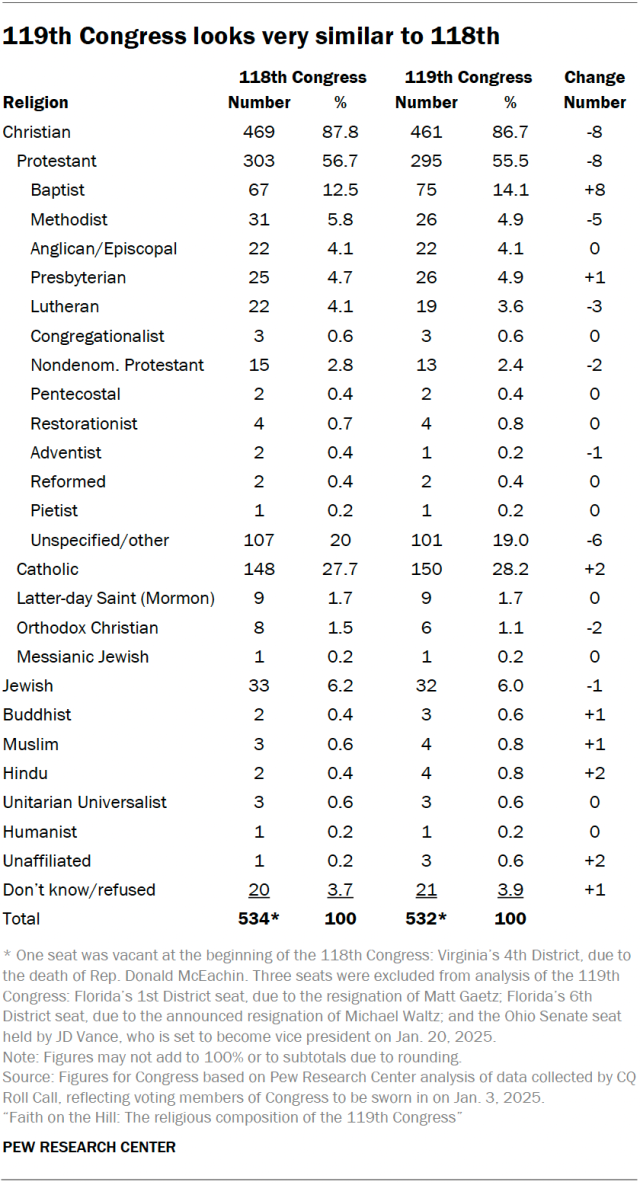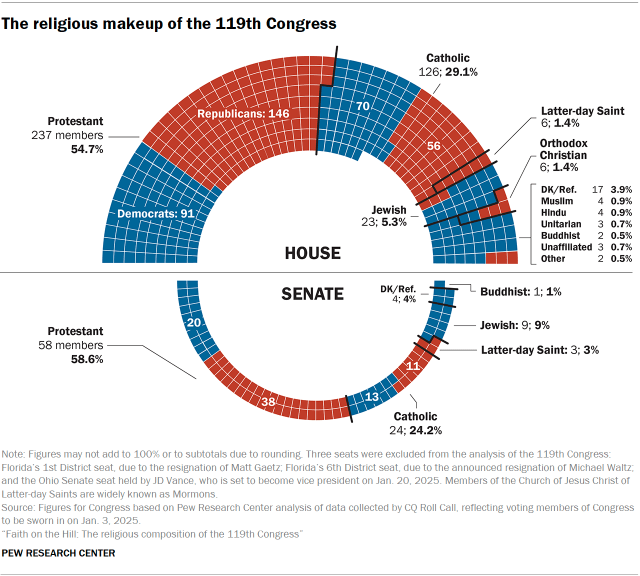(ZENIT News / Washinton, 01.04.2024).- As the 119th United States Congress convenes, its composition offers a fascinating lens into the evolving religious landscape of the nation. While the Congress remains overwhelmingly Christian, its makeup reflects subtle but significant shifts in religious affiliation over the years. These changes are part of a broader societal transformation, marking a steady decline in Christian affiliation among Americans and a modest increase in religious diversity within the legislative body.

The Dominance of Christianity, but Signs of Decline
Christianity continues to dominate the 119th Congress, with 87% of voting members identifying as Christian—a slight drop from the previous session’s 88%. This figure starkly contrasts with the broader U.S. population, where only 62% of adults identify as Christian. A decade ago, the Christian presence in Congress was even more pronounced, standing at 92%, underscoring a gradual but persistent decline.
Today, the Congress counts 461 Christians among its members, down from 469 in the last session and 491 in the 2015-17 session. This represents the lowest number of Christians in Congress since the 2009-2011 session, the first for which the Pew Research Center began tracking this data.
Protestants and Catholics: Shifting Numbers
Protestants make up the largest group within the Christian members of Congress, with 295 representatives and senators, accounting for 55% of the body. However, this figure is significantly lower than historical norms; in 1961, there were 398 Protestant members. Over the past decade and a half, the number of Protestants has hovered below 300 in six out of nine sessions.
Among Protestant subgroups, Baptists hold the largest representation with 75 members, a small increase from the previous session. Other Protestant denominations such as Methodists (26 members), Presbyterians (26), Episcopalians (22), and Lutherans (19) have seen their numbers steadily decline, reflecting broader trends of shrinking membership in these denominations across the U.S.
The Catholic presence in Congress stands at 150 members, a slight uptick from the last session but below the average of the past 15 years. Catholics comprise 29% of the House and 24% of the Senate, maintaining a prominent, though slightly diminished, influence.

A Growing Religious Mosaic
While Christianity remains the majority, non-Christian faiths are gradually gaining representation, reflecting the increasing diversity of the American population. The 119th Congress includes:
- 32 Jewish members, down by one from the previous session but still comprising 6% of Congress, compared to just 2% of the U.S. adult population.
- Four Muslims, including new entrant Lateefah Simon (D-CA), marking a record high.
- Four Hindus, double the number from the last session, including freshman member Suhas Subramanyam (D-VA).
- Three Buddhists, with Derek Tran (D-CA) joining incumbents.
- Three Unitarian Universalists, all returning members.
Additionally, three members identify as unaffiliated, a rare stance in Congress despite the rising number of “nones” (those without religious affiliation) among the general population. These members include Yassamin Ansari (D-AZ), Emily Randall (D-WA), and Abraham Hamadeh (R-AZ).
Religious Affiliation by Party
Partisan lines reveal distinct religious trends:
- Republicans: Nearly all Republican members (98%) identify as Christian, with a majority Protestant (68%) and a significant minority Catholic (25%).
- Democrats: While three-quarters of Democrats in Congress are Christian, the party also accounts for the majority of non-Christian members, including most Jews, Muslims, Hindus, Buddhists, and the unaffiliated.
Newcomers: Diverse and Less Christian
The 73 new members of the 119th Congress reflect a trend toward less Christian representation. Only 78% of these freshmen identify as Christian, compared to 88% of returning members. Newcomers are also less likely to be Protestant (47%) and more likely to belong to minority faiths or have no affiliation at all.
Congress vs. the Nation: A Stark Contrast
Despite these incremental changes, Congress remains far more religious—and overwhelmingly Christian—compared to the general U.S. population. While nearly three in ten Americans (28%) are unaffiliated, less than 1% of Congress identifies this way.
This gap underscores the unique nature of religious identity in political representation. While America becomes more religiously diverse and secular, its legislative body remains rooted in longstanding traditions of Christian dominance.

Looking Ahead
The 119th Congress encapsulates a dynamic intersection of tradition and change. While the Christian majority remains robust, incremental shifts in religious affiliation hint at a broader societal evolution. As the nation continues to diversify, it will be interesting to see how future sessions of Congress mirror—or diverge from—these trends.
Thank you for reading our content. If you would like to receive ZENIT’s daily e-mail news, you can subscribe for free through this link.




